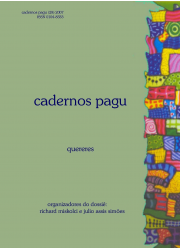Resumen
Nesta versão condensada de seu livro homônimo, Sedgwick esboça uma reflexão sobre o “armário” como um dispositivo de regulação da vida de gays e lésbicas que concerne, também, aos heterossexuais e seus privilégios de visibilidade e hegemonia de valores. A pesquisadora norteamericana afirma que “o armário”, ou o “segredo aberto”, marcou a vida gay/lésbica no último século e não deixou de fazê-lo mesmo após o marco de Stonewall em 1969. Sedgwick argumenta ainda que esse regime, com suas regras contraditórias e limitantes sobre privacidade e revelações, público e privado, conhecimento e ignorância, serviu para dar forma ao modo como muitas questões de valores e epistemologia foram concebidas e abordadas na moderna sociedade ocidental como um todo.
Abstract
In this condensed version of her book, Sedgwick reflects about the “closet” as a regime of regulation of gay and lesbian lives that is also important to heterosexuals since it guarantees their privileges. Sedgwick affirms the “closet”, or the “open secret”, has been basic to lesbian/gay life for the last century even after Stonewall (1969). She also states that this regime - with its contradictory and constraining rules and limits about privacy and disclosure, public and private, knowledge and ignorance – has served to shape the way in which many questions about values and epistemology were comprehended in the Western Society as a whole. .
Key Words: Closet. Open Secret. Knowledge, Sexuality. Truth
Citas
BRAY, Alan. Homosexuality in Renaissance England. Londres, Gay Men’s Press, 1982.
CRAFT, Cristopher. Kiss-me with Those Red Lips: Gender and Inversion Bram Stoker’s Dracula. Representations (8), 1984.
DOUGLAS, Lord Alfred. Two Loves. The Chamaleon (1), 1894.
HALLEY, Janet E. The Politics of the Closet: Towards Equal Protection for Gay, Lesbian and Bisexual Identity. UCLA Law Review (36), 1989.
HALPERIN, David M. One Hundred Years of Homosexuality. New York, Routledge, 1989.
HUNTER, Nan. Notes: The Constitutional Status of Sexual Orientation: Homosexuality as a Suspect Classification. Harvard Law Review 98, abril de 1985, pp.1285-1307.
KATZ, Jonathan. Gay/Lesbian Almanac: A New Documentary. New York, Harper & Row, 1983.
KOEDT, Anne, LEVINE, Ellen e RAPONE, Anita. (orgs.) Radical Feminism.
New York, Quadrangle, 1973.
LA MORTE, Michael W. Legal Rights and Responsibilities of Homosexuals in Public Education. Journal of Law and Education (4), 32, 1975, pp.449-467 LAURITSEN, John e THORSTAD, David. The Early Homosexual Rights Movement. New York, Times Change Press, 1974.
MAGER, Don. Gay Theories of Gender Role Deviance. SubStance (46), 1985.
MILLER, D. A. The Novel and the Police. Berkeley/Los Angeles, University of California Press, 1988.
RACINE, Jean. Esther. H. R. Roach (ed.), Londres, George G. Harrap, 1949.
RICH, Adrienne. Compulsory Heterosexuality and Lesbian Existence. In: STIMPSON, Catherine R. e PERSON, Ethel Spector. (orgs.) Women, Sex and Sexuality. Chicago, Chicago University Press, 1980.
SCHOLZ, Jeanne La Borde. Comment: Out of the Closet, Out of a Job: Due Process in Teacher Disqualification. Hastings Law Quarterly (6), 1979, pp.663-717.
SEDGWICK, Eve Kosofsky. Epistemology of the closet. Berkeley, University of Califórnia Press, 1990.
__________. Privilege of Unknowing. Genders (1), 1988.
__________. Between Men: English Literature and Male Homosocial Desire. New York, Columbia University Press, 1985.
STEAKLEY, James D. The Homosexual Emancipation Movement in Germany. New York, Arno Press, 1975.

